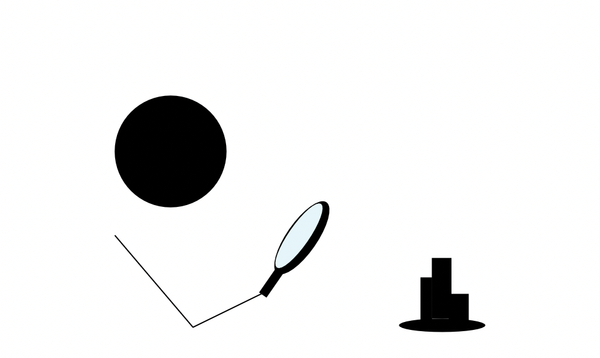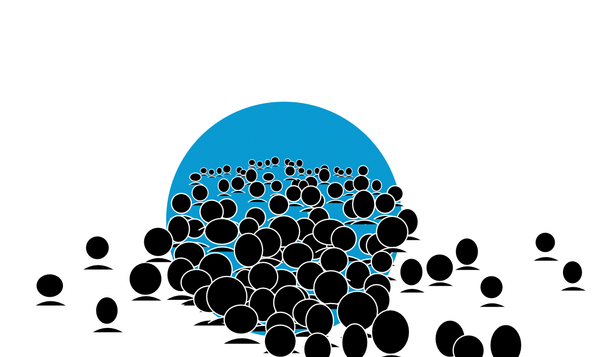Thought experiment with information architecture #1
How did we get here? Hiring with a preference for “looking right” rather than trying to have real conversations around skills and ethos? Originally published on Medium.

How did we get here? Hiring with a preference for “looking right” rather than trying to have real conversations around skills and ethos? So much of our money in the hands of so few? Economic striation to the point of unhousing on one side, multiple multi-million-dollar houses spanning the globe on the other? Our homes filled with stuff and more stuff, and then some stuff to contain and organize it all? Our ecosystems collapsing around us while we still fight about whether or not it’s happening? Putting new laws on our books — now, today, in our modern world — intended to persecute those who do not conform to the constrained sliver of other people’s idea of what reality should be, with those who don’t fit…well, they will. If they don’t, it’s on them.
And if that means they die, fast or slow? It’s on them. Biology does not conform to your magical will? It’s on them. It doesn’t actually hurt anything other than short-sighted sensibilities? It’s on them.
How did we get here? How are we fighting the same fights of generations ago, restated, rather than building on what we understood?
I think one of the fulcrum points is actually embedded in that long list of questions. Money is in too few hands, and it skews the whole.
Have you thought about how we think about money?
I’m not talking economics, or balancing books, or capitalism vs. socialism, etc. Rather, it’s the structure of how the information flows — the connectome — that I’ve been thinking about.
“Money is god,” someone said to me. I don’t remember who, I don’t remember the context, but the tone I remember. Part dismissal, part bewilderment, part ridicule, with the tiniest inflection of sarcastic question. Money is god.
It lingered. Money is god. It’s not, but for many people all things flow to to money. It sits at the top of a hierarchy, and people have a tendency to see hierarchical structures as being built from the top down even if it wasn’t. They impose their current navigation on the construct as though it was the always-state.
We like hierarchical information structures. They are easier to navigate. Follow the information scent, always drilling down, never needing to worry about what else exists outside of the current context, and that current context a nice, finite chunk with enough meaning that we feel like we know something. If we need to recalibrate, it’s a matter of backtracking and moving forward in a different direction. Our sense of orientation — knowing where we are — is stronger in a hierarchy, because of the structural simplicity.
A network? Ugh. A few steps of following information scent and, if we don’t have a great memory and always-on attention: lost. Where did we start? How do we get back?
So while reality is a network, we love to impose hierarchical structures to improve our confidence, actionability, and overall sense of mastery. We did it with money, too.
We put money at the top, and all things supporting the accumulation of money below it. Being the top of a hierarchy is god-ish; all things are categorized under it, all things work for it, and it is included meaning in all things.
If we think about it in the broadest of brushstrokes, the core components of being able to make money are people, resources, and infrastructure to help the right people get attached to the right resources at the right point in time. It’s pretty simple, really. As we dig in complexity skyrockets, and entire lifetimes of understanding become drops in the bucket. This is just a high strata, but it still gives us insight.

Business with profit at the top of a hierarchy will look at people either as employees or buyers, stripped down to the primary differentiator. Working towards your goal and costing the business money, or consuming the attained goal and earning money for the business. In neither instance are people, well, people. They are oriented towards their use, not their being; and in so doing silo’d from their human needs. It’s easy to say that if housing gets too precious for the $15/h you are willing to pay them that it’s on them for accepting their lot in life; it’s on them for not figuring out reasonable housing for themselves; it’s on them for being only this responsible. Also, it’s on them when no one will take the $15/h job, because how any employee manages outside of that description is on them. They just need to show up, at a rate where profit can be maintained and heightened, and do their job.
We know these behaviors.
Business with profit at the top of a hierarchy will look at resources as commodities that need to be processed as elegantly as possible in order to realize the fullest potential profit. Speed, efficiency, and access to the raw materials are what will be cared about. Government standing in the way of full access to everything they could use? Anti-business! How those resources are supporting more than business? It literally doesn’t compute in a hierarchical structure. Those are silos. They don’t interact.
We know this behavior.
And infrastructure? It’s there. It’s to be used. Why pay for what already exists? Why also not scream to high heaven that any infrastructure that doesn’t meet needs has failed? It needs to be punished — no extra taxes! Linger in failure due to lack of funding? Now it’s a dysfunctional infrastructure: that’s an opportunity for business to improve and build profit.
We know this behavior, too.
Taking a couple half steps
Go ahead and skip this part if you want. Come back to it if the next section is too big a change.
The first has the same categories, still with money on top so you don’t need to completely reorient. But connections drawn between what were disconnected silos in the other model. To be clear, we could absolutely go deeper. Every person type could be connected to every resource and every infrastructure. After all, we all need to eat, and we’re all needing to get somewhere, somehow in our modern world. The internet is an infrastructure, and you’re using it now to read this.

And then I started thinking about how we name things, and how we chunk things. What if we didn’t attribute how money interacted with people in our structure, but whether they were focused on the same goal? What if we chunked up the resources amongst how/if it was replaced? What if we thought about infrastructure not as just the path from A to B, but in key qualities of that path?
Naming and classification are important attributes. Naming tells people whether you expect them to respect or dismiss someone (Sleepy Joe, Crooked Hillary, Pocahontas), or even entire categories of someones. These are not nothings. These skew thoughts, twist behaviors, and are insidious. So thinking about people only as how they are useful? Not a great start. Lumping the finite resources of the earth in with renewable resources? Not a realistic idea of how carefully we should use them.

Then, mind limbered, I took away all the lines, changed out the layer-able bricks for fungible circles.

It’s no longer what-is-known. It’s no longer attributing how to understand the bits and pieces, and with which other bits and pieces it is contextualized. We can take this, and look at nature-as-it-functions, and see what happens.
Surprise, surprise
I entered my what-if thinking believing it would be a network structure, the underpinning of system. I was limbering up my mind to attribute that system. First, though, I needed the structure.
I wish I had taken snaps of the structure during different points. The complexity was…amazing. It was so connected, so multivariate, that the lines of connection were hard to trace. Everything, to everything else.
People need water, and air, and earth on which to abide; we deeply depend on biologicals that feed us, cloth us, and shelter us. We need to be able to navigate them all, whether they are infinite possibility, constrained and elegant by nature, or built by humans. Through it all, I kept money to the side: it was just as interconnected to everything as people, and even without it the connections were information overload.
I started consolidating the lines. Still busy; less informative. I asked more questions. Until finally I was left with something resembling this. I couldn’t make the overlaps work on a couple things, so I fudged with lines. And finally, I placed economy, aka money.

Money isn’t the top of the hierarchy. It’s lensed that way to help build understanding when in focus and keep everyone on the same page; these lenses are useful as long as we understand they are lenses, and not the singular truth. When we really think about money and how it is mirrored in the natural world, money isn’t anywhere near a god.
Money is a tool. Money is simply a way to figure out who can use what.
Think about this
Changing information structures can be mind boggling; it why I usually share at least one transitional model. By changing structures, we are changing the way we contextualize and develop meaning around a bit of information. The sky remains blue, is still recognized as sky; but, the way we think about it in terms of lake, mountain, atmosphere, etc., is no longer the same. We change our orientation and navigation. We change our map to understanding reality and understanding each other.
Really think about how we contextualize money. It is central to our modern existence. Without it, or without enough of it, we do not eat. Our homes, once a symbol of The American Way, is not in financial scope. Our pipes are allowed to leach lead. We chose the expediency of petroleum-based plastics over investment in alternatives whose primary issue is that their wealth-building power isn’t quantified and with limited risk. We allow our skies to fill with a carbon load that will kill a large fraction of this geological epoch’s life if left unchecked. We’re missing that key understanding that without natural resources, without the supporting network of complex biological life, and without people, there is no money. We are part of the whole, and money a part of us. The rest of our planet can survive without us, and without our money; we can’t survive without it.
When so much money is in so few hands, it’s a weaponized tool: the person who has lots can do what they want, the person who has little has to manage with little. People are people. In all our wonder, in all our meanness, we are people. Interpersonal behavior and leverage have come into play, heightened by desire and need.
Money is a tool. We are allowing a hammer to dictate our existence. Everything beyond the hammer — how it’s used, how big it gets, what it means, what materials are used to make it — is all people, our behaviors, and our agreements. Change the agreements, and we change the tool.
It’s easier to see what agreements could be changed when we reconsider the model.




